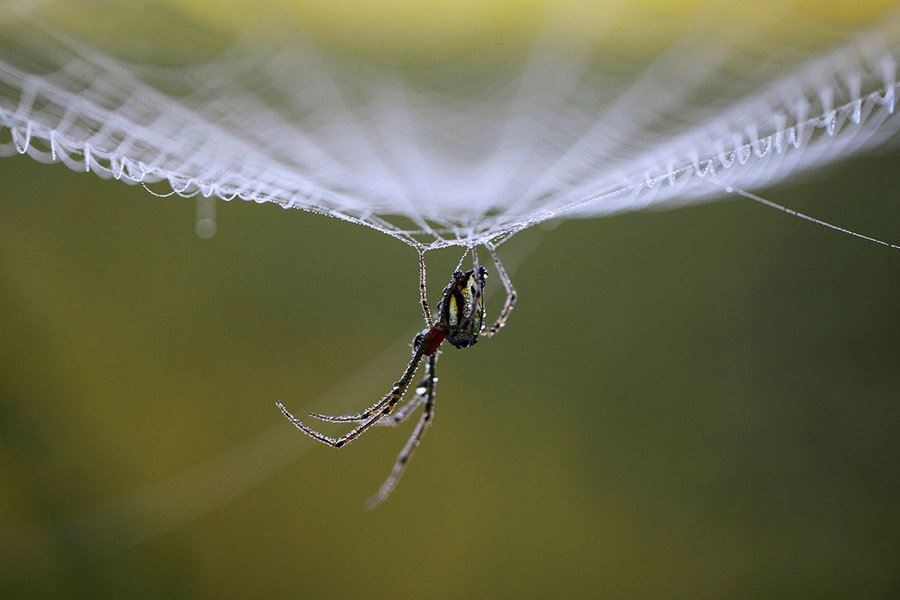Reprinted with permission from The Christian Science Monitor
Spiders may owe their evolutionary success to one unusual organ.
—Some time more than 300 million years ago, an ancient arthropod evolved a trait that would become the bane of countless insects and, today, people walking through their basements. Fed by a set of microscopic spigots secreting a material that is, ounce for ounce, stronger than steel, this organ gives its bearer the ability to catch prey, protect its eggs, and hitch a ride on the wind.
 Dewdrops gather on a spider as it rests on its web during the early morning in Lalitpur, Nepal.Navesh Chitrakar/Reuters/FileKnown as a spinneret, this organ is key to a spider’s ability to direct its silk precisely. And it might just explain why spiders have been such an evolutionary triumph.
Dewdrops gather on a spider as it rests on its web during the early morning in Lalitpur, Nepal.Navesh Chitrakar/Reuters/FileKnown as a spinneret, this organ is key to a spider’s ability to direct its silk precisely. And it might just explain why spiders have been such an evolutionary triumph.
“They’re one of nature’s great success stories,” says Charles Griswold, an arachnologist with the California Academy of Sciences in San Francisco. Spiders survived the “Great Dying” mass extinction of 252 million years ago. They scuttled around dinosaur legs. Today, there are about 47,000 different species of spider living on every continent except Antarctica.
So how did we end up with all these spiders?
“The usual way a scientist goes about answering this question is that they look at the features that seem to have evolved to make a spider a spider,” says Jonathan Coddington, senior scientist and curator of arachnids and myriapods at the Smithsonian Institution National Museum of Natural History in Washington. And a spider’s iconic well-spun silk is one of its unique traits.
Spiders haven’t always made the intricate webs we see – and sometimes don’t – today. When spinnerets first evolved, they probably were used for simpler things, like wrapping spider eggs in silk or lining a burrow. Even today, not all spiders make webs. But they still spin out threads of silk for other purposes, such as carrying eggs or “ballooning,” using a silk parachute to ride the air currents.
“These are all things that have been possible because of using silk,” says Jason Dunlop, curator of Arachnida and Myriapoda at Berlin’s Natural History Museum. “And I think that’s one of the key reasons why they’ve become such a successful group.”
Although spiders’ silky feats are impressive, it turns out that they haven’t always been the only arachnid with spinnerets. An extinct arachnid species called Chimerachne yingi found preserved in 100-million-year-old Burmese amber also has spinnerets and other spiderlike features, as described in two papers published in the journal Nature on Feb. 5, one of which is co-
written by Dr. Dunlop.
These amber-encased creatures are not spiders. They also bear the same primitive features as other arachnids, so researchers say they belong to a separate lineage that likely diverged just before the first true spider appeared, some 300 million years ago.
“To me the most amazing thing is that something that we thought had gone extinct 300 million years ago, it survived for another 200 million years,” says Gonzalo Giribet, a senior author on one of the papers and professor of evolutionary biology at Harvard University in Cambridge, Mass.
Other factors, such as the use of venom, could also contribute to spiders’ evolutionary success, Dr. Coddington says.
Regardless, Dr. Griswold says, “They hit upon a lifestyle, a very long time ago, and it worked and it has continued to work.
Page created on 4/10/2018 11:06:34 PM
Last edited 4/10/2018 11:17:17 PM
